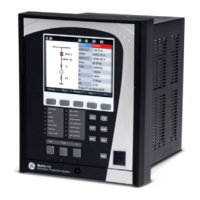CHAPTER 3: INTERFACES SOFTWARE INTERFACE
889 GENERATOR PROTECTION SYSTEM – INSTRUCTION MANUAL 3–45
FlexCurve Editor The FlexCurve Editor is designed to allow the user to graphically view and edit the
FlexCurve. The FlexCurve Editor screen is shown as follows:
• The Operate Curves are displayed, which can be edited by dragging the tips of the
curves
• A Base curve can be plotted for reference, to customize the operating curve. The Blue
colored curve in the picture is a reference curve. It can be Extremely Inverse, Definite
Time, etc.
• The Trip (Reset and Operate) Times in the tables and curves work interactively i.e.,
changing the table value affects the curve shape and vice versa.
• The user can save Configured Trip Times.
• The user can export Configured Trip Times to a CSV file
• The user can load Trip Times from a CSV File
• The screen above shows the model followed by 889 for viewing FlexCurves. Select
Initialize to copy the trip times from the selected curve to the FlexCurve.
Transient Recorder
(Waveform Capture)
The software can be used to capture waveforms (or view trace memory) from the relay at
the instance of a pickup, trip, alarm, or other condition.
• With software running and communications established, select the Records >
Transients > Transient Records menu item to open the Transient Recorder Viewer
window.
•Click on Trigger Waveform to trigger a waveform capture.
• To view the captured waveforms, click on the Launch Viewer button. A detailed
Waveform Capture window appears as shown below.
•Click on the Save button to save the selected waveform to the local PC. A new window
appears, requesting the file name and path. One file is saved as a COMTRADE file, with
the extension "CFG." The other file is a "DAT" file, required by the COMTRADE file for
proper display of waveforms.
• To view a previously saved COMTRADE file, click the Open button and select the
corresponding COMTRADE file.

